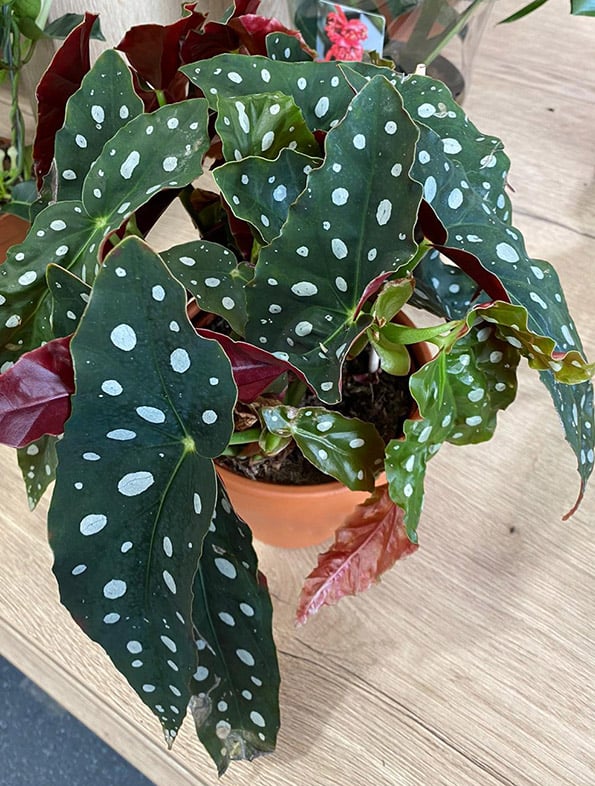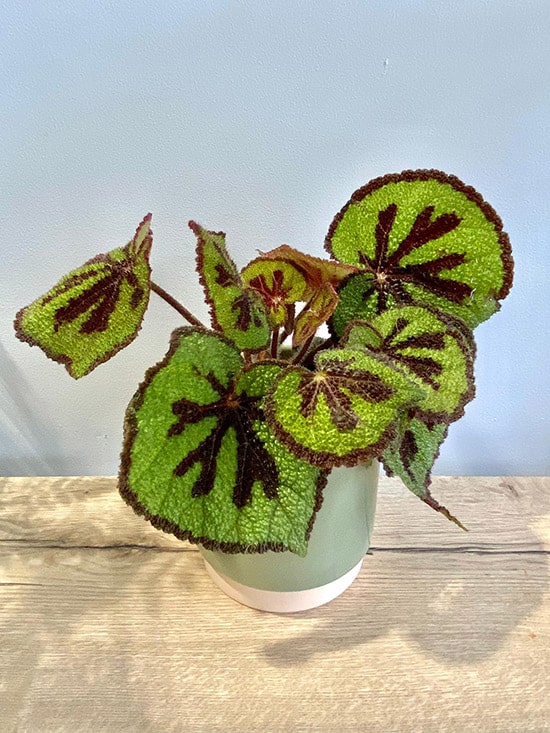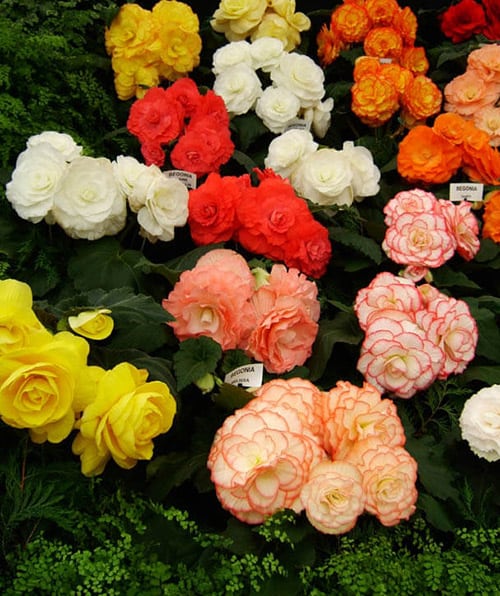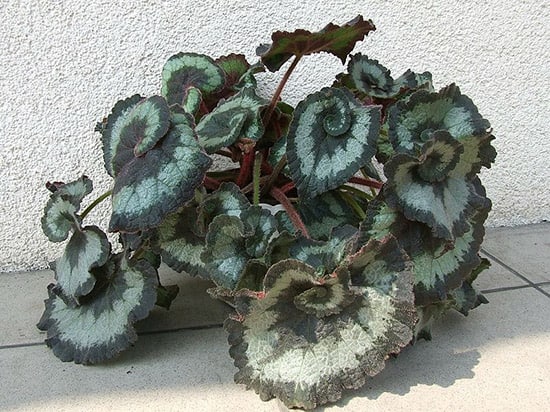Begonias are perhaps one of the most enduring and traditional houseplants you'll come across. They're easily loved but can equally be hated for being "old fashioned plants Grandmother used to grow".
Regardless, for the most part they're easy going, tolerant and somewhat forgiving of occasional poor care. The choice in variety is truly huge with close to 1000 species and thousands of cultivars. While almost all commercially grown Begonias are cheap to purchase some of the rarer varieties could set you back a little.

Begonia maculata 'Polka Dot' houseplant
Broadly, the type of Begonia you can grow as a houseplant will fall into one of two categories. There are the foliage types, which are grown primarily for their aesthetically pleasing and unusual leaf shapes, colorings and markings.
There are so many varieties and different looking foliage Begonias to pick from, so just choose the patterns you like best when purchasing.
The second option are the flowering types with their impressive blooms. The leaves might not be much to look at this time around, but the blooms more than make up for this. Again pick a plant you like the look of choosing one with only a few flowers open and plenty of buds to prolong the display.
Once you've either a flowering or foliage type of Begonia it's further divided into groups based on how it looks or how it grows. The most popular types are are Cane, Rhizomatous and Tuberous Begonias. The care requirements are quite similar, but each will have a little difference that you need to be aware of and respect for a successful long term relationship.

Begonia masoniana 'Iron Cross'
The Cane Begonias were likely the indoor plants grown by your Grandmother, with their brittle thick canes that had slightly hairy knobbly stems giving an almost arthritic appearance, which is not attractive by today's standards.
The variety on offer is huge and thankfully the modern varieties that are commonly sold are often a little more compact and less "leggy". They can still spread far and wide if you let them however so it's important to keep them pruned and trained if you want to maintain a smaller controlled looking houseplant.
All the Cane Begonias are typically evergreen meaning they can be kept indoors all year round as permanent house guests without losing leaves in Winter. Flowering is possible at any time of the year but during the Autumn and Winter months are the most common.
The Tuberous Begonias (below) are popular with outdoors gardeners because of the wonderful flower display they put on over the Summer that last for months and months. This is also the same reason they're grown indoors as houseplants.

Several tuberous Begonias in flower showing off huge blooms - Photo by Darorcilmir
The tubers which grow under the soil surface store a huge amount of energy which in turn allow for some impressive looking large flowers that are produced for most of the Summer. After flowering has finished it's typical for the plant to enter dormancy.
You can grow these houseplants from year to year (see anything else section), but their need for dormancy to recover for next years display means they'll only be a temporary house guest.
The Rhizomatous Begonias (below) are normally the foliage types, and have a possible advantage of being much smaller than the Cane and Tuberous Begonias.

Escargot is a Rhizomatous Begonia - Photo by Jerzy Opioła
They often flower in Spring and although the blooms might not be as impressive as the flowering types, this is probably the more balanced Begonia plant overall it. It has attractive foliage to keep you entertained all year around, does not die back in Winter and still gives you some blooms to appreciate.
The sheer diversity on offer means there is likely something for everyone. Some of the popular names you'll find on the plant labels are "Wax Begonia", "Angel Wing Begonia" and "Rex Begonia".

Hi, I'm Tom!
If you're like me and enjoy the challenge of growing houseplants and getting them to thrive, then Ourhouseplants can help. This website shares my knowledge and years of growing plants and provides (hopefully) helpful advice on properly caring for your indoor plant friends.
All Begonias types just need a good bright location out of direct sunlight and they're all set to grow, look beautiful and flower happily. The flowering types struggle in dark or very poorly lit areas where as the Begonias grown purely for foliage fair a little better.
No Begonia will be happy for very long if exposed to direct harsh sunlight, so this needs to be avoided.
Begonia problems in the majority of cases can be traced back to a watering issue, either too much or too little and often it's the former.
They of course need water like any houseplant, especially when growing strongly, but as soon as you give too much the problems start. They rot easily and diseases like Botrytis can strike. The soil needs to dry out a little between each watering, so when in doubt about whether to water again wait a few more days.
Most problems that effect Begonias can be traced back to a watering issue.
Begonias do prefer humid locations if given the choice and will often struggle in very dry arid places in your home, such as near fireplaces and by radiators.
The normal ways you might increase humidity such as misting the leaves or placing your plant in a steamy bathroom will often not work well, because Begonias dislike intense constant moisture on their leaves. Instead your choice of placement is more important.
They can be hungry plants at certain times of the year, so it's a good idea to feed your Begonia when it's growing and flowering. Once every month during this period is probably realistic and a good approach to take. If you've a tuberous type look for a feed high in potash / potassium to support the blooms. If you've another type of Begonia a standard houseplant feed is perfect.
The normal usual home temperatures are fine for all Begonias and they aren't overly fussy about occasional highs or lows in temperature. Although you must avoid any prolonged exposure to temperatures which are approaching freezing.
Young plants and cuttings will need repotting as they grow, but established plants will only need repotting every couple of years at most. This is primarily to refresh the growing medium, rather than due to their expanding root growth.
The Rhizomatous Begonias should be grown in shallow rather than deeps pots, because their roots stay near the soil surface and deep pots will only encourage watering problems.
You can propagate quite simply through stem/cane cuttings or in some case through leaf cuttings. Rhizomatous and Cane Begonias often have creeping stems that grow close to the soil surface forming roots as they do so. This means you can remove a section of the stem complete with roots.
Pot up in a new container with similar potting mix to the parent and lay the cutting on the moist soil surface, burying it slightly, and in a few weeks you should have signs of new growth.
Begonia growth will be moderately fast if given good correct care.
If you want to give leaf propagation a go, remove a leaf including its stem and then push the stem into a moist soil mix (a rooting hormone on the buried end will increase your chances), firming gently to keep everything anchored in place.
The leaf should now be sticking out looking like an umbrella or a flag pole. Water only a little and keep the soil barely moist to discourage rotting. It will also work better if you use a type of cloche to keep humidity levels high.
Propagating Begonia's by leaf cuttings is a lot slower, but if it works you should get small plantlets growing around the base after a couple of months.
How fast a Begonia grows will depend on the type you have as well as the time of year. However in general, during the warm months of the year, and with correct care, growth will be moderately fast.
Due to the very high number of different types of Begonia you can find the height and spread of a plant really does vary.
There are dainty plants not growing much taller than 3 inches / 7cm, and others which are over 3ft / 90cm. Generally speaking most of the common Begonias you can buy are of average size and won't outgrow their chosen placement..
All Begonia plants will flower at some point and sometimes it's the main point of the plant, and others it's a bonus. Take a look at the gallery and pictures on this article for some ideas of what the variety of flowers can look like.
The blooms can appear at anytime of the year and will only last a short time, however because the plant will normally produce lots of flowers in succession you may not notice the old ones dying off as they are replaced by the new ones. The entire display can last anything from a few weeks to several months.

Photo by KENPEI
The leaves and stems in most types of Begonia contain small levels of calcium oxalates which produce generally unpleasant side effects. However the concentration in the underground tubers is usually more significant and so you must keep exposed tubers away from children and pets.
The Tuberous Begonia types grow from tubers and will go dormant when the days start getting shorter in Autumn and Winter. Simply allow your plant to enter this state naturally.
The leaves will yellow up and then crisp up or fall off, leaving nothing alive above the surface. Clear up the fallen debris and cut off any of the remaining stems to just above soil level. Do not water at all and once the soil has dried out almost completely move the entire pot to a frost free but cool location for a few months.
They can be restarted in Spring by watering a little and bringing back into the light and heat.
Yellow leaves on my houseplant Begonia
If you've a Tuberous Begonia this is to be expected when the temperature reduces in Autumn / fall. If the yellow is confined to the tips of the plant then it's potentially caused by lack of water or feeding.
Brown papery blotches
This sounds like sun damage. You need to move your plant away from the burning sun to prevent more blotches from appearing.
Leaves going brown and wilting
Too much water combined with cooler temperatures normally causes this problem. Be extra careful not to overwater your Begonia going forward. If the damage is significant you may have to propagate a new plant and start again.
My Begonia is very leggy
Older cane types tend to have a leggy reaching look about them, which can simply be pruned out by cutting back the plant if you don't like the appearance. For the other types of Begonia however this is unusual and normally an indication too little light has been provided.
My plant is just generally "sickly"
If overwatering is prolonged then Botrytis may have taken hold. This is a fungus that attacks weakened plants kept in cool damp conditions. Move to warmer spot and treat with a fungicide if necessary. Moving your plant outdoors into natural airflow and the elements will also aid its recovery (providing it's warm enough of course!)
A white film which looks like a light dusting of flour
Almost certainly a case of powdery mildew which unfortunately is pretty common on Begonias. The cause is opportunistic fungi spores that thrive on certain plants found in warm, damp locations with poor ventilation.
Remove the badly infected mildewed leaves and then spray with a product containing Myclobutanil, Penconazole, Flutriafol or lightly dust the leaves with Sulphur to give control.
Credit for top view of the Begonia with red / orange flowers - Gallery - Andrey Korzun (Kor!An)
Credit for flowering Begonias in a row - Article / Gallery - KENPEI
Credit for Begonia rex 'Escargot' - Gallery - Jerzy Opioła
Credit for Begonias at the Hampton Court Flower Show - Article / Gallery - Darorcilmir